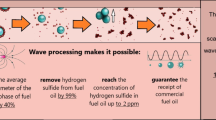Abstract
One of the main characteristics of a petroleum disperse system (PDS) is the average particle diameter of the dispersed phase. The simplest and most affordable analytical method to determine this characteristic is photoelectrocolorimetry. It has been shown that the use of low-energy wave (constant magnetic field of 0.1–0.4 T, ultrasound of 50 kHz) treatment and hydrogen sulfide scavengers leads to a change in the degree of dispersion of the system along with the degree of removal of hydrogen sulfide, which is determined from the residual hydrogen sulfide content in fuel oil. The method makes it possible to study the interaction of PDS structural elements and provides information on the disperse composition of fuel oil, which can be used to determine the most favorable conditions for the removal of hydrogen sulfide from fuel oil.





Similar content being viewed by others
REFERENCES
O. F. Glagoleva and V. M. Kapustin, Pet. Chem. 58, 1 (2018).
Z. I. Syunyaev and R. Z. Safieva, Petroleum Disperse Systems (Khimiya, Moscow, 1990) [in Russian].
B. P. Tumanyan, Scientific and Applied Aspects of Theory of Petroleum Disperse Systems (Tekhnika, Moscow, 2000) [in Russian].
R. Z. Safieva, Physical Chemistry of Petroleum (Khimiya, Moscow, 1998) [in Russian].
O. F. Glagoleva, Neftepererabotkaineftekhimiya, No. 4, 10 (2013).
N. A. Pivovarova, Pet. Chem. 59, 559 (2019).
T. Klokova, O. Glagoleva, Yu. Volodin, and L. Smirnova, Physicochemical and Dispersion Properties of Oils and Oils Products (RGU, Moscow, 1997) [in Russian].
S. G. Zimina and N. A. Pivovarova, Nauchn. Tr. AstrakhanNIPIGAZ, No. 8, 119 (2006).
N. A. Pivovarova, B. I. Belinskii, O. N. Kozyrev, and B. P. Tumanyan, Khim. Tekhnol. Topl. Masel, Nos. 1–2, 9 (2003).
N. A. Pivovarova, A. S. Grazhdantseva, G. V. Vlasova, and V. M. Kolosov, Khim. Tekhnol. Topl. Masel, No. 1, 3 (2018).
N. A. Pivovarova, G. V. Vlasova, T. V. Sal’nikova, and E. S. Akishina, in Proceedings of II International Scientific–Technical and Investment Forum on Chemical Technologies in Oil and Gas Processing “Petroleum Chemistry’2019” (Minsk, 2019), p. 20 [in Russian].
P. R. Veles and N. A. Pivovarova, RU Patent No. 2167824 (2001).
F. G. Unger, Fundamental and Applied Results of Investigation of Petroleum Disperse Systems (INKhP RB, Ufa, 2011) [in Russian].
Funding
This work was supported by the Russian Foundation for Basic Research, project no. 18-29-24001.
Author information
Authors and Affiliations
Corresponding author
Ethics declarations
The authors declare that there is no conflict of interest to be disclosed in this paper.
Additional information
Translated by M. Timoshinina
Rights and permissions
About this article
Cite this article
Pivovarova, N.A., Vlasova, G.V., Akishina, E.S. et al. Relationship between the Degree of Dispersion of Fuel Oil and the Degree of Removal of Hydrogen Sulfide from It. Pet. Chem. 60, 716–721 (2020). https://doi.org/10.1134/S0965544120060080
Received:
Revised:
Accepted:
Published:
Issue Date:
DOI: https://doi.org/10.1134/S0965544120060080




